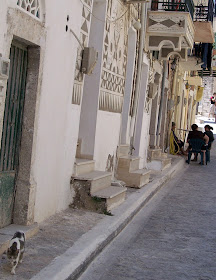I often write about art painted on exterior walls—for
instance the Murals of the Mission District, San Francisco and the Wynwood
Walls in Miami. I’ve even written
about the artistic graffiti of Oaxaca, Mexico.
Pirgi is a fortified village, designed to foil and confuse
pirates. Only on Chios will you
find the mastic tree, which produces a resin that has made the people rich
since the 14th century. Mastic is a gun-like sap that seeps out of
the tree. TheTurkish sultans and
their harems loved it as chewing gun and candy and for medicinal
purposes. Today Mastic is more popular than ever for cosmetics, perfumes and cooking.
The citizens of Pirgi, with their uniquely scraped walls and
their famous mastic trees have one more unique claim to fame. They believe that Christopher Columbus
came not from Genoa but from a Ksista-decorated house in Pirgi, and some
historians believe them.
Old and young men in Pirgi just chillin' under the strings of tomatoes.
Here is wall art inside a very ancient church in Pirgi. The winged figure over the window represents the Holy Spirit.









Ooooooh... Aaaaaaah... it's gorgeous! This I'd love to see in person :O)
ReplyDeleteIt's a fantastic town to walk through and eventually make it to the House of Columbus (the supposed ancestral home of Columbus). I've heard that since the island was under Genovese control, it makes sense that Columbus may have been on the island. Further, the island was once a powerful and important in naval terms and the military trained there.
ReplyDeleteLastly, the angel in the wall painting is actually a six-winged seraphim. In Greek, an exapterygo. Besides the six wings, the words beside it are 'Holy, Holy, Holy Lord', which is an abbreviated form of the never-ending prayer.
Thank you, Matthew, for letting me know about the seraphim. It's a wonderful image.
ReplyDelete